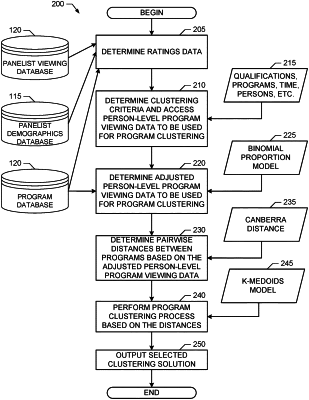| CPC H04N 21/44222 (2013.01) [G06Q 30/00 (2013.01); H04N 21/25891 (2013.01); H04N 21/44204 (2013.01)] | 18 Claims |

|
8. An apparatus comprising:
means for adjusting person-level program viewing data to determine adjusted person-level program viewing data, the means for adjusting to:
access respective person-level program viewing data that is to represent lengths of time respective people in an audience have tuned to respective ones of a plurality of television programs to be clustered; and
determine the adjusted person-level program viewing data for respective ones of the people having tuned to respective ones of the television programs, first person-level program viewing data for a first one of the people having tuned to a first one of the programs to be adjusted based on a first ratio that is to characterize a relationship between (i) a first program rating associated with the first one of the people having tuned to the first one of the programs and (ii) a first network rating associated with the first one of the people having tuned to a first network associated with the first one of the programs, the first ratio based on division of a numerator value by a denominator value, the numerator value based on a difference between the first program rating and the first network rating, the denominator value based on the first network rating and a total duration of the first one of the programs; and
means for clustering the ones of the plurality of television programs into clusters based on distances between pairs of the television programs, the distances based on the adjusted person-level program viewing data.
|